So Toque & Canoe is just back from Jasper, Alberta’s fourth annual Dark Sky Festival – a full-on event celebrating the national park’s Dark-Sky Preserve status.
The weekend was packed with beyond epic star-gazing (“who threw all that glitter in the sky, anyway?” asked one attendee), hiking (no big deal, just hung out with an elk herd that happened to be bathing in a nearby mountain river) and delicious dining opportunities (Evil Dave’s Grill partnered with Alberta Culinary Tourism Alliance on a stellar menu.)
To be sure, it’s not every day you get to chat with members of The Royal Astronomical Society of Canada about the politics of light pollution and the critical importance of dark sky preserves (access to the stars is our birthright, some will say)—let alone meet our country’s most famous travelling spaceman. Special guest Chris Hadfield blew us away with his animated, intelligent—and often funny—lecture on space travel. We won’t ever forget his heartfelt references to the “unconscious” beauty of our planet, as seen from space.
Speaking of space, Canada’s Paul Zizka, whose distinct brand of astro-photography has struck a chord the world over, attended the event as the festival’s feature photographer. Given Paul’s expertise, we thought it might be fun to share some of his images and check in with his affection for the night sky.
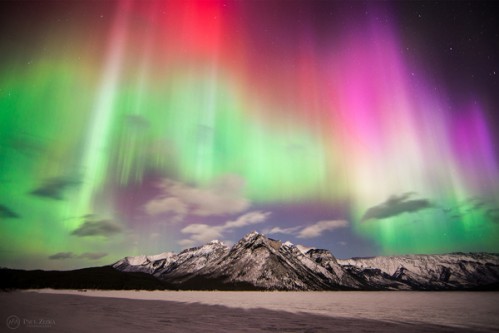
Lake Minnewanka, Banff National Park / Photo by Paul Zizka
T&C: What is it, specifically, about the night sky that has captured your imagination?
Paul Zizka: For me, it’s about experiencing the suggestion of worlds out there that may be like our own. All you see are little points of light and everything else is left to your imagination. There is so much to dream about. The sense of scale that the sky gives us—the huge size of it all and the distance involved—is mind-boggling. Of course, the night sky can be beautiful, too – with all those twinkling little things up there and the amazing colours of the aurora borealis. But my interest goes beyond this.
T&C: Have you always been fascinated by stars? Or is astro-photography something you came into later in life?
Paul: I wasn’t the kid who grew up loving the telescope at the age of four. My parents weren’t into astronomy or astro-geology. My interest developed as I spent more and more time in the outdoors and under dark skies. What struck me was how right it felt to finally establish a relationship with the sky. It’s like parenting. I’m a new dad and before my daughter was born, I wasn’t sure how I was going to handle it. Then when it happens to you, you realize it’s in you, and it’s been there all along.
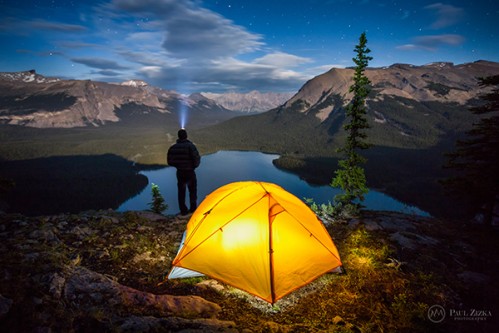
Sunset Pass, Banff National Park / Photo by Paul Zizka
T&C: Can we explore this idea a little further? Why is it worthwhile for people to tip their chins to the heavens at night and take them in?
Paul: For me, so much of it is about perspective. You’re out there looking at things that are so old, so big, so far away. It puts your own life and your own little issues into perspective. The universe is telling you you’re not here for a very long time so there’s no use worrying about it. Historically, people were connected to the skies but now, it’s a cluttered kind of world. You have to put effort into making that connection and then when you’re out there, under the stars, it just feels so right. It’s where we all come from. It’s past primal.
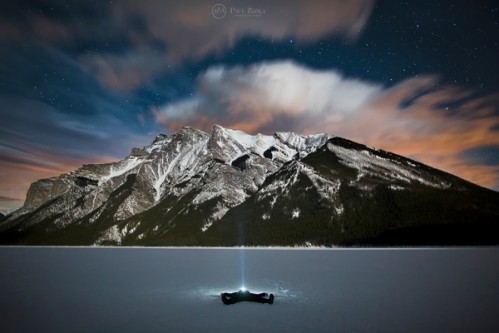
Lake Minnewanka, Banff National Park / Photo by Paul Zizka
T&C: What are you trying to communicate to your audience with your dark sky imagery?
Paul: The umbrella hope is to make people want to experience the night sky for themselves—to bring them back to nature in general and see what wilderness can do for them. If I can play a part in making that happen, then it’s very rewarding for me. It may be dark, and cold and, really, who would want to be there? Yet you want to be there. It’s so beautiful. I should probably be more careful and worry more about the cold, or wildlife, or the distance from help if I need it—but nothing bad has happened yet. We’re so used to being in light with all the technology around us that we’ve become afraid of the dark. It’s not rational. Everything is the same as during the day, but the lights are out. Of course, you still need to go out there with at least a little common sense.
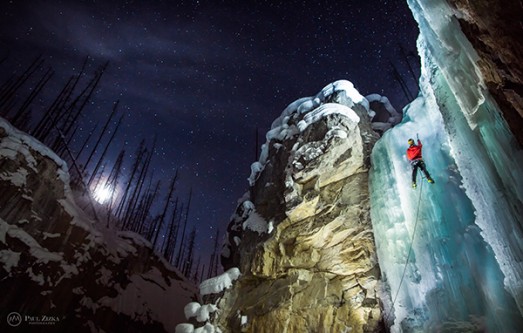
Haffner Creek, Kootenay National Park / Photo by Paul Zizka
T&C: You’ve had quite an impressive run since we spoke with you last. A successful time lapse project. International press. A new book. What does Paul’s Zizka’s future look like?
Paul: With this field of work—with photography as a way to feed your family—the business plan is not always the way to go. I’ve had more success going with the flow and being open to opportunities. I’m interested in developing more mountaineering photography, higher elevation stuff and shooting glaciers, as well. They’re interesting to me. They’re heavily documented in the Rockies, but from a distance. With safety in mind, I’d like to examine glaciers from inside the ice. Some are difficult to access, but others are a bit more broken up so it’s easier to get inside. It’s such a surreal world. Whatever I’ll be doing, you can be sure it will involve rediscovering the place that I love most—the mountains.
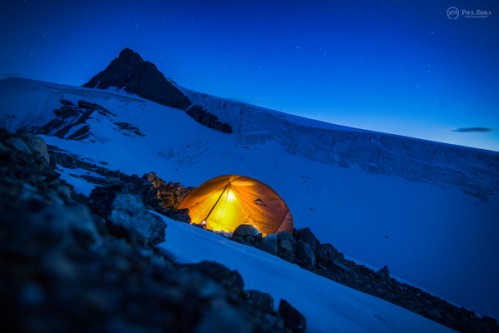
Jasper National Park / Photo by Paul Zizka
Editor’s note: Writer Kim Gray was a guest of Tourism Jasper during her time at the Jasper Dark Sky Festival. This story was not approved or reviewed before publication.


john commented:
We did a series on the book, by Barbara Brown Taylor called “Learning to Walk in the Dark,” that is about embracing our dark not in fear, rather as teacher, wisdom etc.
these photos /story remind me that night is gift! awesome…thx j